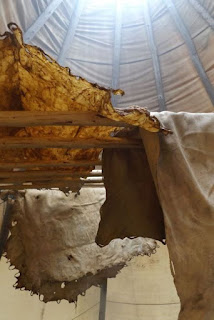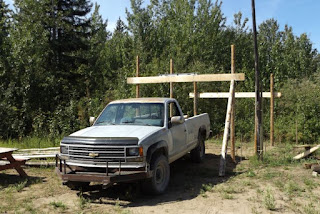We started working on hides in May. As an aside this is when the fires of Fort Mac Murray were going on and this is what the smoked looked like here one morning as I was going to work on the first hide.
Anyway, here are the photos, if you look carefully you can see that there was two hides.
The hide is stretched and we can start working on it.
Fleshing it
Scraping the hair off.
That one, a third hide, I tried to save but it was quite rotten and full of maggots and turned out to be too thin to scrape properly. Afraid to make more and more holes I didn't scrape it enough and as a result it could not be tanned. To tan it I would have to rescrape it and it is too thin for that.
This is the tanning solution (in the bottle) made of cooked brain, soap and lard.
This is the hide in the very first picture, tanning solution has been applied and since it was sunny it is sitting in the sun for a few days.
The second hide had to be put over a small fire at the same stage because there was no sun. (notice the small tipi is being put to good use and one of the pole is resting on it)
The final smoking: This is actually a good example of what not to do, too much of the smoke is escaping.
The rotten spruce wood used in the process
One of the hides (the second one) once it is tanned and soft but before the final smoking.
and here it is all done.


















































